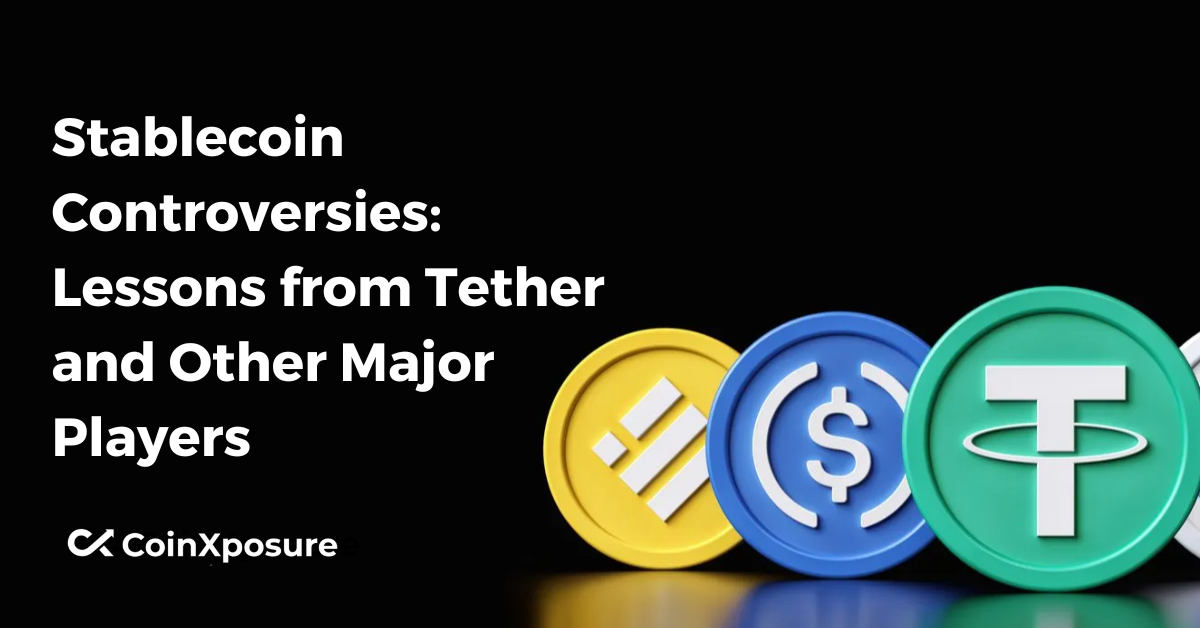
Stablecoin Controversies – Lessons from Tether and Other Major Players
Stablecoins, a class of cryptocurrencies designed to minimize the volatility often associated with digital assets, have become integral to the cryptocurrency market. These digital currencies, typically pegged to stable assets like fiat currencies or commodities, offer a bridge between the traditional financial system and the emerging realm of decentralized finance (DeFi).
However, the journey of stablecoins has been fraught with controversies, with Tether (USDT) at the forefront of scrutiny. This article sets the stage for exploring the controversies surrounding stablecoins, drawing lessons from Tether and other major players in the field.
From concerns about transparency and regulatory compliance to debates on centralization versus decentralization, the landscape of stablecoins is rich with challenges and opportunities that warrant a closer examination.
This exploration delves into the key issues, lessons learned, and the potential future trajectory of stablecoins in the broader financial ecosystem.
Tether: The Controversial Leader
Tether (USDT), a stablecoin with a purported 1:1 peg to the US dollar, has earned the dubious distinction of being a controversial leader in the cryptocurrency space. Launched in 2014, Tether quickly became a linchpin for traders and investors seeking a stable value in the volatile world of cryptocurrencies.
However, the controversy surrounding Tether revolves around its claims of having equivalent reserves in US dollars to back the circulating supply, a crucial promise for any stablecoin.
One of the primary issues haunting Tether is the lack of transparency regarding its reserves. Unlike other stablecoins that have undergone third-party audits to validate their claims, Tether has faced persistent criticism for failing to provide conclusive evidence of its 1:1 USD backing.
The absence of a comprehensive and public audit has fueled skepticism within the crypto community and has attracted regulatory scrutiny.
Legal challenges have further compounded Tether’s controversies. The company behind Tether, Bitfinex, has faced legal actions from authorities, including allegations of misleading investors about the nature of Tether’s backing.
These legal battles have raised questions about Tether’s stability and regulatory compliance, influencing market perceptions and contributing to its tumultuous reputation.
As regulatory authorities worldwide tighten their grip on cryptocurrency, Tether’s role as a stablecoin leader is increasingly under scrutiny. The outcome of ongoing legal proceedings and regulatory investigations may reshape the landscape for Tether and set precedents for the broader stablecoin industry.
In examining Tether’s controversies, one gains insights into the challenges facing a specific stablecoin and the broader issues surrounding transparency, regulatory compliance, and trust in the evolving realm of digital assets.
Other Major Stablecoins and Their Controversies
Other major stablecoins have not been immune to controversies, each facing unique challenges that contribute to the ongoing discourse around the stability and reliability of these digital assets. Let’s explore some of the notable stablecoins and the controversies associated with each:
- USDC (USD Coin)
- DAI
- Binance USD (BUSD)
USDC (USD Coin)
- Centralization Concerns: USDC has faced criticism for its centralized nature, as it operates under the governance of regulated financial institutions. This has led to concerns about the potential for censorship and regulatory intervention.
- Regulatory Challenges: As a regulated stablecoin, USDC is subject to regulatory oversight, raising questions about how it navigates compliance issues and potential conflicts with the decentralized ethos of the broader crypto space.
- Relationship with Circle and Coinbase: USDC is issued by regulated financial companies, including Circle and Coinbase. The relationship with these entities raises questions about how closely tied stablecoins should be to centralized platforms and traditional financial institutions.
DAI
- Decentralized Governance Challenges: DAI, designed to be a decentralized stablecoin, faces governance challenges inherent in decentralized autonomous organizations (DAOs). Decision-making and protocol adjustments require consensus among holders of the MKR token, which can be complex and contentious.
- Stability Issues and Collateral Risks: DAI’s stability depends on the collateral backing it. Market fluctuations and potential liquidations of collateral assets can pose risks to the stability of DAI, and maintaining a balance is an ongoing challenge.
Binance USD (BUSD)
- Regulatory Challenges and Binance’s Involvement: Binance USD, issued by Binance, has faced regulatory scrutiny due to its association with one of the largest cryptocurrency exchanges. Questions arise about how regulatory challenges the parent company faces might impact the stablecoin.
- Adoption and Market Perception: BUSD’s adoption and market perception influence Binance’s standing in the crypto space. Changes in Binance’s reputation or regulatory status can have a cascading effect on BUSD.
Exploring these controversies reveals the multifaceted nature of stablecoins and the challenges they encounter in maintaining stability, decentralization, and regulatory compliance. Each stablecoin’s journey contributes valuable lessons to the ongoing evolution of the broader cryptocurrency ecosystem.
Lessons Learned from Stable Controversies
Here are some lessons learned from stablecoin controversies:
- Transparency is Non-Negotiable
- Regulatory Compliance is Vital
- Decentralization Balancing Act
- Market Perception Matters
- Investor and User Protection is Paramount
- Innovation Requires Responsible Practices
Transparency is Non-Negotiable
The lack of transparent and verifiable reserves can lead to skepticism and erode trust in stablecoins. Lessons from controversies, especially in the case of Tether, underscore the importance of regular audits and transparent reporting to assure users and regulators of a stablecoin’s legitimacy.
Regulatory Compliance is Vital
Stablecoins operate in a regulatory environment that is becoming increasingly stringent. Instances of legal challenges and regulatory scrutiny emphasize the necessity for stablecoin projects to prioritize compliance, adhere to regulatory frameworks, and establish clear communication channels with authorities.
Decentralization Balancing Act
Decentralization is a core principle in the cryptocurrency ethos, but the challenges faced by decentralized stablecoins like DAI highlight the need for a careful balance. Striking the proper equilibrium between decentralization and practical governance is crucial for stability and adaptability.
Market Perception Matters
The reputation of stablecoins is closely tied to the entities backing them. Controversies surrounding exchanges or parent companies can significantly impact stablecoin adoption and market perception. Stablecoin projects must navigate the delicate balance between aligning with reputable entities and maintaining independence.
Investor and User Protection is Paramount
The stability of stablecoins directly impacts users and investors. Lessons from controversies emphasize the importance of implementing safeguards to protect users from risks associated with market fluctuations, collateral issues, and potential regulatory interventions.
Innovation Requires Responsible Practices
As stablecoins continue to evolve, innovation must be coupled with responsible practices. Experimentation with new technologies and models should prioritize risk mitigation, security, and adherence to ethical standards to ensure the long-term sustainability of stablecoin projects.
In navigating the complexities of stablecoin controversies, these lessons provide valuable insights for developers, regulators, and users. As the cryptocurrency landscape matures, applying these lessons will be instrumental in shaping a stable and trustworthy future for digital assets.
Future Outlook for Stablecoins
Here are the future outlook for stablecoins:
- Enhanced Regulatory Frameworks
- Increased Adoption in Traditional Finance
- Technological Innovations
- Mainstream Integration
- Increased Diversity of Stablecoin Models
- Audit and Transparency Standards
Enhanced Regulatory Frameworks
Expect an evolution in regulatory frameworks specific to stablecoins. Governments and regulatory bodies will likely provide more precise guidelines, defining the legal status and compliance requirements for stablecoin issuers. Increased regulation may bring stability and legitimacy to the sector.
Increased Adoption in Traditional Finance
Stablecoins are poised to play a larger role in traditional finance. As regulatory clarity improves, stablecoins may become more widely accepted by financial institutions for cross-border transactions, settlements, and other use cases, bridging the gap between traditional and crypto finance.
Technological Innovations
Anticipate continuous technological advancements in stablecoin protocols. Innovations in decentralized finance (DeFi) and blockchain technology may lead to more robust and efficient stablecoins. Cross-chain interoperability and integration with other blockchain projects could become focal points of development.
Mainstream Integration
Stablecoins may integrate further into mainstream financial services and applications. Developing user-friendly interfaces, mobile applications, and seamless integration with existing financial infrastructure could drive wider adoption among businesses and individuals.
Increased Diversity of Stablecoin Models
The success and challenges of various stablecoin models will likely lead to the creation of diverse approaches. Algorithmic stablecoins, commodity-backed stablecoins, and other innovative models may emerge, offering users a range of options with different risk profiles and use cases.
Audit and Transparency Standards
The demand for transparency and verifiable reserves will likely drive the establishment of industry standards for audits. Stablecoin projects may voluntarily undergo regular, independent audits to build and maintain trust among users, investors, and regulators.
The future of stablecoins is dynamic and contingent on the evolution of technology, regulation, and market demands. As the industry matures, the role of stablecoins in the broader financial ecosystem will likely become increasingly significant and influential.
Conclusion
Stablecoins, despite their controversies, stand as a pivotal force in shaping the future of cryptocurrency and traditional finance.
The lessons gleaned from the tumultuous journeys of stablecoins, particularly exemplified by the controversies surrounding Tether and other significant players, offer valuable insights for the continued development of this essential asset class.
As stablecoins navigate legal challenges and regulatory scrutiny, their role in traditional finance is poised to expand. The potential integration of stablecoins into mainstream financial services offers a bridge between traditional and crypto economies, with the prospect of increased efficiency and reduced friction in global transactions.
The journey of stablecoins is one of adaptation, innovation, and maturation. As the industry learns from its past, navigates present challenges, and embraces a dynamic future, the trajectory of stablecoins will likely be marked by increased resilience, credibility, and a more significant role in the broader financial ecosystem.
The lessons from controversies serve as guideposts, steering the industry toward a future where stablecoins play a vital role in reshaping the landscape of finance.





